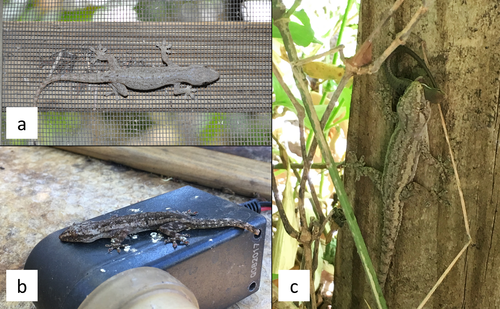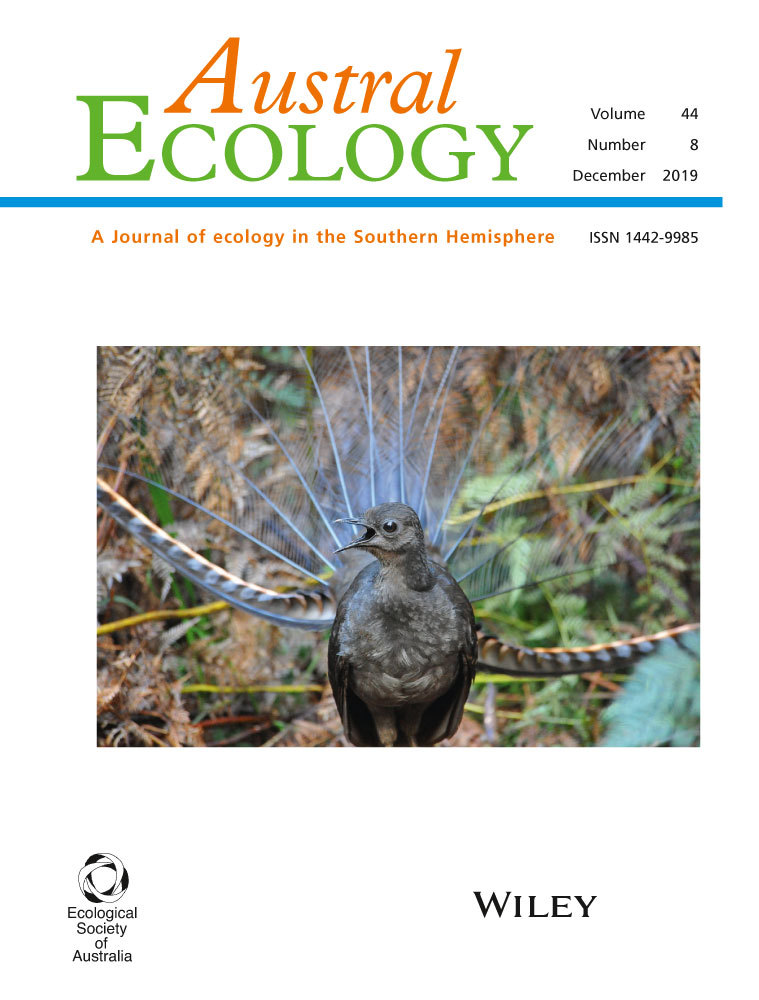Potential impacts of intraguild predation by invasive Asian house geckos
Abstract
The introduction of the Asian house gecko, Hemidactylus frenatus, to mainland Australia has sparked considerable debate in regard to its potential impacts on native lizard species. Their historically patchy distribution across Australia has gained attention as populations have spread into peri-urban and native bushland. Hemidactylus frenatus potentially pose a threat to native species through competition and predation. I documented some activity of H. frenatus during the day, including foraging, which may broaden the potential impacts to diurnal species. Here, I highlight (i) the potential impact of predation by H. frenatus on native lizards and (ii) the need for empirical studies directly quantifying competitive encounters, with special interest in intraguild predation.
Invasive species, regardless of intentional or accidental introductions, often cause major problems for native communities. However, some invasive species have caused more problems for ecological systems than others (e.g. cane toads in Australia; Shine 2010; brown tree snakes on Guam; Savidge 1987; Burmese pythons in south Florida, USA; Dorcas et al. 2012). One species that has been the centre of debate regarding its impacts is the introduction of the Asian house gecko, Hemidactylus frenatus to mainland Australia (Hoskin 2011; Vanderduys & Kutt 2012). Asian house geckos are among the most wide-spread reptiles in the world, primarily due to their accidental introductions. These medium-sized geckos (mean snout-vent-length (SVL) = 49 mm; n = 240; Cornelis et al. 2019) are often stow-a-ways on cargo ships, trucks and planes (Greer 1989). Adults, juveniles and eggs are often transported on, or in, boxes, commercial goods and in potted plants (Selcer 1986; Gill et al. 2001).
Asian house geckos are hardy generalist predators, well adapted to a variety of habitats and conditions (Newbery & Jones 2007). While H. frenatus are generally a nocturnal species, they are occasionally seen thermoregulating or foraging throughout the day (E.J. Nordberg, pers. obs., 2014–2019; Fig. 1a–c). To date, H. frenatus occupy mainly urban and peri-urban habitats (Newbery & Jones 2007; Hoskin 2011; Barnett et al. 2017; Coates et al. 2017), foraging around artificial lights on buildings and man-made substrates (Zozaya et al. 2015). Due to Australia's extensive gecko diversity (Hoskin 2011; Cogger 2014) hypothesised that H. frenatus pose a potential threat to Australia's native gecko fauna as they have displaced native species on Pacific Island systems (Bolger & Case 1992; Case et al. 1994; Brown et al. 2002). Hemidactylus frenatus have spread into bushland habitats, which will potentially add competitive pressure on native species (Hoskin 2011; Barnett et al. 2017). Hemidactylus frenatus are similar size to some native house geckos (e.g. Australian house gecko, Gehyra dubia, mean SVL = 49 mm; n = 1493; Nordberg & Schwarzkopf 2019) and are less aggressive (both as resident and intruding individuals) than native G. dubia (Cisterne et al. 2019). Further, H. frenatus are competitively subordinate to another native house gecko, Gehyra australis, and modified their substrate use in the presence of native G. australis near Darwin, NT, Australia (Yang et al. 2012). Australian house geckos (e.g. G. dubia) are less likely to explore exposed habitats or forage around artificial light fixtures (Newbery & Jones 2007), but rather ambush prey from the shadows, even when H. frenatus are removed (Zozaya et al. 2015). Therefore, it appears that H. frenatus alter their preferences to avoid encounters with native geckos and may occupy more ‘available/open niches’ with less competition (e.g. anthropogenic structures), rather than displacing native geckos.

Diurnal activity is not commonly observed in H. frenatus, but tends to be limited to shaded areas out of direct sunlight in the early morning or evening, but is not commonly observed (Bustard 1970). However, here I present three photographs of diurnally active H. frenatus (Fig. 1a–c) and have observed multiple sightings of H. frenatus during the daytime, generally basking on shaded building walls and infrastructure. As Australia already supports numerous gecko species in the ‘house gecko niche’, I ask whether H. frenatus may alter their diel preference to minimise overlap and direct competition with nocturnal gecko species. A shift in activity time has not been documented previously, but due to Australia's high gecko diversity and limited available niche space, it is possible that H. frenatus behaviourally shift their activity preference into a more vacant ecological niche. However, this hypothesis requires further investigation. In addition, if H. frenatus can be active during the day as well as night, diurnal species (such as skinks; Fig. 1c) may be susceptible to competition and predation.
Hemidactylus frenatus occupy natural bushland habitats up to 2 km from the nearest anthropogenic structure (Barnett et al. 2017; Coates et al. 2017). The question, however, remains: does this invasion into bushland habitats pose a serious threat to native lizards? Few studies have empirically tested this, but they have generally focused on competition, in terms of refuge-site selection (Yang et al. 2012) and aggressive behaviours (Cisterne et al. 2019) or dietary overlap (Newbery & Jones 2007). Additional factors that may represent threats to native species include predation and foraging success.
To my knowledge, no studies have directly compared the foraging capabilities of H. frenatus against a native Australian gecko in an experimental set-up. It would be interesting to see how the interactions would play out in an experimental encounter between H. frenatus and a native species, for example G. dubia, competing for a limited resource (e.g. a food item), given the native species are more aggressive (Cisterne et al. 2019) and may suppress the subordinate H. frenatus. However, H. frenatus are more willing to explore exposed areas (E.J. Nordberg, unpubl. data) and therefore may encounter the food item before the native. Hemidactylus frenatus are efficient foragers of arthropods (Canyon & Hii 1997; Tkaczenko et al. 2014), often actively searching for prey, as opposed to many Australian native geckos, which are predominantly sit-and-wait ambush predators (Cogger 2014). In addition to arthropod prey, H. frenatus will prey upon juvenile lizards of native species (Fig. 1c) and cannibalise other invasive geckos (both H. frenatus and Mourning geckos, Lepidodactylus lugubris; Bolger & Case 1992; E.J. Nordberg, pers. obs. 2014–2019). Predator–prey interactions are difficult to monitor in natural settings and are rarely observed. Further, it is easy to cast-off unique or rare predation events as ‘one-off occasions’ or ecologically insignificant observations (Nordberg et al. 2018). Predation pressure from H. frenatus may pose an additional threat to native lizards in general, not only geckos. Hemidactylus frenatus are more tolerant of sharing space and shelter sites than native geckos (Petren & Case 1998; Brown et al. 2002; Cisterne et al. 2019), and therefore small refugia may support a relatively dense population of geckos. Increased H. frenatus densities may result in higher predation of juvenile native species.
The consumption of other lizards by H. frenatus is representative of intraguild predation, which is a combination of predation and competition whereby both species rely on the same resources (Polis et al. 1989). The benefits for the consumer include eliminating a competitor while simultaneously obtaining a resource (food via predation). This complex trophic interaction is often difficult to quantify, but can have marked effects on food web dynamics and community structure (Polis & Holt 1992). Few studies highlight the potential effects of competition with native species, but I suspect that intraguild predation, which accounts for both predation and competition, should be investigated.
Given that H. frenatus have shown some activity during the day, thrive in highly disturbed habitats, are tolerant of intra- and interspecies occupation of shelters, are active foragers and possess a generalistic and opportunistic diet, further study is warranted to identify the impacts H. frenatus has on native species with special emphasis on intraguild predation.




